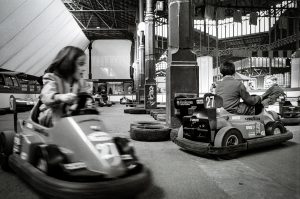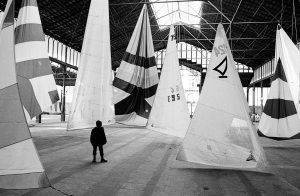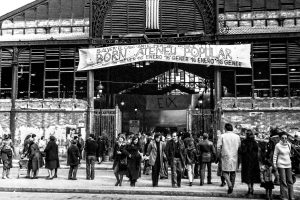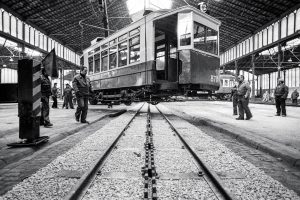
Born revindicated (1971-2001)
From 11 July to 27 November 2017
Free entrance
Records of the Born market date back to medieval times, in the square bearing the same name. Over the centuries, trade was conducted in the open air, until the market stalls found a new home inside the recently constructed metal building in 1876.
From the second half of the 20th century, this became the main wholesale fruit and vegetable market, until these activities were moved to the Mercabarna logistics centre in Zona Franca in 1971.
Thus began a new era for the Born. Amidst revindication and uncertainty, it became a space that was used in a totally different way from its previous life as a market. The photographic legacy of that time allows us to delve into the main events.
BORN REVINDICATED
The scene of a long, intense fight for recognition by residents, between 1971 and 2001 the Born became one of the hubs of Ciutat Vella, perfect for the large-scale activities that needed a big, covered, enclosed venue: concerts, political rallies, exhibits, fairs, theatre and festivals. All of these found their place within the old structure of the former fruit and vegetable market, while the echoes of Francoism could still be heard in the squares and streets. Quite a varied combination of events that gave this area a whole new personality, and breathed new life into this space and the neighbourhood that was struggling to re-emerge among the first glimmers of the democratic transition. The Born welcomed the flourishing social and artistic activity of the time, which was at once exciting and uncertain.
BORN OF THEATRE
The former market was also the stage of many performing arts shows. As in other activities, the wide variety of styles and themes was the leitmotif, always with a sense of the revindicating the neighbourhood and civic-mindedness. The carnival festivities held there are a good example of this. In terms of theatre, one of the most noteworthy plays put on was Don Juan Tenorio (1976), part of a series of social and professional revindication events organised by the Assemblea de Treballadors de l’Espectacle (Standing Conference of Actors and Directors), which had just been set up. It also coincided, expressly, with the first anniversary of Franco’s death. The cast featured mostly “up-and-comers” in Catalan theatre like Juanjo Puigcorbé, Assumpta Serna and Sílvia Munt, among others, directed by Mario Gas. These actors later went on to become true stars, of both stage and screen.
BORN, THE BUILDING
One of the neighbours’ first demands was for the building to be preserved and restored, as it was already seen as an important part of the city’s historical heritage. While markets of this type had been torn down in other European cities, cultural heritage and architects’ associations insisted on the importance of preserving it. Several projects were submitted to refurbish the old building and, thanks to pressure from neighbours, it was fully restored for the first time between 1977 and 1982. The building in its decadent state was used to shoot some of the scenes for Alice in Spanish Wonderland (1978), by director Jordi Feliu (1978). In the film, the “ruins” of the Born were used as a metaphor for Spain as a country full of ups and downs, with the effervescence of anti-establishment feelings within the fragility of the first democracy.
BORN OF EXHIBITS
The large enclosed space of the old market also became the perfect place for all sorts of exhibits and fairs. The first was «Roses and floral art», in 1978. This was followed by others like the renowned exhibits «Public works in Catalonia» (1982), used to explain the new infrastructures being built at the time; «Catalonia, factory of Spain», focusing on the industrial revolution (1985); and «Sports planet» (1989), in the run up to the Barcelona Olympics.
BORN OF POLITICS
With the arrival of democracy, the area attracted the attention of political parties taking part in the first elections, during the Transition. They were interested in the Born because it was one of the few large, covered venues in Ciutat Vella. Furthermore, the new politicians were well aware of the power of the residents in the neighbourhood and of the Association of Neighbours in the Casc Antic which headed up some of the most notorious calls for recognition in Barcelona in the 1970s. Over the following decade, most political groups and leaders held some of their largest rallies in the Born. Pictures show marches with the top dogs of the Communist Party, PSC, former Convergència i Unió, Alianza Popular (future PP), etc.
BORN OF CONCERTS
One of the activities that most reflected the revindicative character of the neighbourhood was, without any doubt, the concerts held there. The monumental nature of the building made it perfect for many, many performances, of a wide range of styles, from neighbourhood festivities to rock and jazz festivals to local dances. The concerts held as part of political events played a particularly noteworthy role. Over nearly 40 years, the list of artists and groups that played here is long and notable: from Montserrat Caballé and Dyango to Nina Simone, as well as singer-songwriters like Joan Manuel Serrat, Lluís Llach, Pau Riba and the Latin-rock of La Salseta del Poble Sec.
BORN OF FAIRS
The special location of the Born and its capacity made it a key location for medium-sized trade fairs, unlike those held at that time at the Fira Barcelona. Some of the most noteworthy were the Book Fair and the Barcelona International Comic Fair. One that stands out in particular was the well-known Collectable Records Fair, founded in 1985 by the recently departed Jordi Tardà, a true music-lover, radio DJ and concert promoter. This fair was held in the market seven years in a row, from 1987 to 1993. Many Barcelona residents still remember the items from huge stars being auctioned off, prized by music-lovers. Other noteworthy fairs included the Fashion Trade Show, AutoRetro Barcelona, Rural Tur and Fabric Trade Show.
BORN OF NEIGHBOURS
After seeing the large number and variety of activities that were held in the Born, it must be noted that they all had one thing in common: using the site for a variety of purposes. After the market was closed, this building became a symbol for residents in the neighbourhood, something to fight for. The events held there are a great example of this, but they were possible thanks to the demands, fighting spirit and steadfastness of the neighbourhood that revindicated the Born.
BORN, A NEW ERA
In the late 1990s, people began to question what the permanent use of the Born should be. Some proposals gained strength, like the idea of the former market housing the Barcelona Provincial Library. Work to adapt the building to this use uncovered the archaeological remains of the old Born neighbourhood, from the 17th and 18th centuries, fossilised under the foundations of the market. The news spread in the media and fanned the flames of debate, with different opinions from the cultural, architectural and political arenas, among others. In the end, excavations revealed its exceptional nature as an archaeological site and studying and raising awareness of the excavations became the foundation on which the Born has consolidated its place as one of the benchmark cultural centres in Barcelona today.







